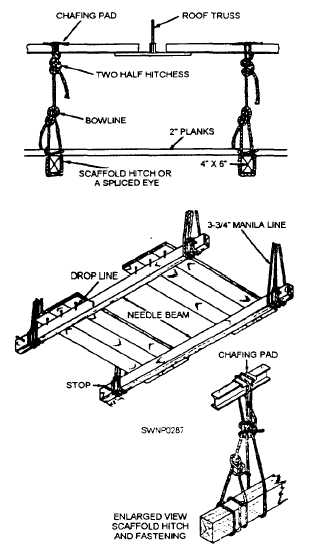Needle-Beam Scaffold
A needle-beam scaffold consists of a plank platform resting on two parallel horizontal beams, called needle beams, which are supported by lines from overhead. (See fig. 6-40.)
Needle-beam scaffolds should be used on-l y for the support of personnel doing light work. They are suitable for use by riveting gangs working on steel structures because of the frequent changes of location necessary and the adaptability of this type of scaffold to different situations.
Several types of patent and independent scaffolding are available for simple and rapid assembly, as shown in figure 6-41. The scaffold uprights are braced with diagonal members, and the

Figure 6-40. - A needle-barn scaffold.

Figure 6-41. - Assembling prefabricated independent scaffolding.
working level is covered with a platform of planks. All bracing must form triangles, and the base of each column requires adequate footing plates for bearing area on the ground. The patented steel scaffolding is usually erected by placing the two uprights on the ground and inserting the diagonal members. The diagonal members have end fittings, which permit easy assembly. The first tier is set on steel bases on the ground, and a second tier is placed in the same manner on the first tier with the bottom of each upright locked to the top of the lower tier. A third and fourth upright can be placed on the ground level and locked to the first set with diagonal bracing. The scaffolding can be built as high as desired, but high scaffolding should be tied into the main structure.
Boatswain's Chair
The boatswain's chair shown in figure 6-42 also comes under the heading of scaffolding. It is sometimes used to provide a seat for a person working above the ground.
The seat of the boatswain's chair should be at least 2 feet long, 1 foot wide, and 1 1/4 inches thick (60 cm
Continue Reading